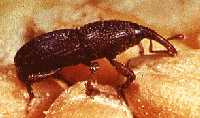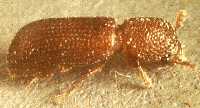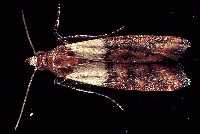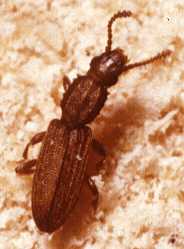by F.B. Peairs 1 (8/2010)
Quick Facts…
- Stored-grain Insects often cause as much loss after harvest as crop pests cause during the growing season.
- Insects cause losses by direct feeding damage and also deterioration and contamination of grain.
- Six steps to prevent and control of insect damage are: keep bins clean and repaired; use residual sprays; store only clean, dry grain; aerate the grain; protect the grain; and inspect the grain regularly.
The profits from producing a crop should not be allowed to waste away in storage. Stored-grain Insects often cause as much loss after harvest as crop pests cause during the growing season. These losses are caused in two ways:
- Direct feeding damage results in reductions in weight, nutritional value, germination and market value.
- Deterioration and contamination from the presence of Insects results in downgrading of grain and market value due to insect parts, odors, molds and heat damage. For example, current FGIS regulations call for the downgrading of wheat to sample grade if the insect levels in Table 1 are exceeded.
| Table 1: FGIS infested designation standards. | |
| Crop | Insects per Kg of grain to receive FGIS “infested” designation |
|---|---|
| Wheat, rye, triticale | More than 1 weevil, or 1 live weevil plus any other live stored grain insect, or no live weevils but 2 or more other live stored grain Insects. |
| Corn, barley, oats, sorghum and soybeans | More than 1 weevil, or 1 live weevil plus any 5 or more other live stored grain Insects, or no live weevils, but 10 or more other live stored grain Insects. |
Stored-grain Insects are divided into primary pests that attack whole kernels and secondary pests that feed on broken or cracked grain. An excellent aid in identifying these Insects is U.S. Department of Agriculture Handbook number 500, Stored-Grain Insects, prepared by the Agricultural Research Service. A much more comprehensive reference is Management of Grain, Bulk Commodities, and Bagged Products, Oklahoma State University Extension Circular E-912.
Although storage conditions in Colorado do not favor stored grain pest Insects, serious infestations can develop, especially in grain held for several years. In an unpublished 1972 study, S. Pilcher found that the common primary stored-grain pests in Colorado were the granary weevil and the lesser grain borer, while the most common secondary pests were the sawtoothed grain beetle and the flat grain beetle. In a more recent USDA study, 25 percent of 159 samples of Colorado farm-stored wheat were infested with an average of 3,645 Insects per bushel of grain. Eighty-six percent of 14 samples of corn averaged 200 Insects per bushel of grain. One of two samples of oats averaged 96 Insects per bushel.
Winter conditions in Colorado are such that losses in the first storage season are minimal and will continue to be if the proper precautions are taken. A six-step prevention and control program is recommended. Registered insecticides can be found in the current High Plains Integrated Pest Management Guide . Read and follow all label instructions.
Six-Step Prevention and Control Program
Step 1: Keep bins clean and repaired.
Never store new grain on old grain, mix it with old grain or store it in a dirty bin. Old grain and debris are the most important sources of Insects that attack new grain. Completely remove and burn all old grain, broken kernels and other debris. Clean anywhere spilled grain may have accumulated, including outside the bins, behind partitions, between walls and under floors. Fill any holes to prevent access by birds and rodents. Check the roof, as moisture from rain and snow can encourage insect development.
Clean harvest and grain-handling equipment before harvest. Avoid storing grain near feed storage, animal feeders or stables. These areas may be sources of grain-infesting Insects.
Step 2: Use residual sprays.
After cleaning, treat all bin surfaces, including removable doors, behind partitions, and under floors, with an approved insecticide about two weeks before storing grain. The dosage will vary with the porosity of the surface being treated. Malathion may not be effective where Indian meal moth is a problem. Remove Insects killed by this treatment to avoid contaminating new grain.
Step 3: Store clean, dry grain.
Moisture of corn should be less than 15 percent, while other grains should be at 12 percent or less. Minimize cracked kernels and other dockage. They allow some grain pests to build up at much lower temperatures than are required with whole grains.
Step 4: Aerate.
Proper aeration of the grain ensures uniform temperatures and thus avoids moisture buildups that encourage mold development. Molds directly affect grain value. They also serve as alternate food sources for some grain pests, which increases the insect problem.
Step 5: Protect the grain.
Insecticides may be used to treat grain as it is moved into storage. Check the label for proper dosages. These materials also may be used to treat the surface of the grain to provide a protective barrier against infestation. This barrier is broken whenever the surface is disturbed, such as during inspections for Insects. Retreatment is recommended after inspections.
If Indian meal moths or other surface-feeding moths are a problem, then consider available treatments given in the High Plains Integrated Pest Management Guide. These are recommended for Indian meal moths, as many populations of this pest are resistant to other insecticide protectants.
Step 6: Inspect grain regularly.
If the grain mass is below 55 to 60 degrees F, inspect grain every two weeks. Above this temperature, inspect it weekly. This will detect new infestations early and avoid extensive damage. Use a grain probe to take samples in a systematic pattern first from the surface (horizontally, about 2 inches deep) and then from the bottom of the grain mass. Inspect both the center and the area near the walls with samples no farther apart than 20 feet.
During probing, “hot spots” may be felt on the grain surface or off odors may be detected. These are indications of insect activity and should be checked. During the colder months, the Insects will congregate in the center of the grain mass, so sampling at that location will be more important. Sift the probe contents through 10-12-mesh screen and examine it for Insects.
Table 1 provides the number of live Insects per kilogram of grain necessary to exceed Federal Grain Inspection Service standards and to be branded as “infested.” Elevators may have stricter standards and may also grade down based on the presence of insect-damaged kernels.
Consider the following alternatives if an infestation is detected:
- Move the grain and retreat as in Step 4. If the move is made during cold weather, some Insects will be killed even without treatment.
- Feed the grain to livestock.
- Fumigate.
Fumigation of Stored Grain
Fumigation is both complicated and risky. Often, it is best to leave fumigation to professionals. Also, fumigators must meet specific certification and licensing requirements. Read, understand and follow all label precautions and instructions. The best advice is to follow Steps 1 through 6 closely to prevent the need for this costly procedure.
Common insect Pests of Stored Grain
 |
 |
 |
| Figure 1: Granary Weevil (Sitophilus granarius). Photo courtesy USDA. | Figure 2: Lesser Grain Borer (Rhyzopertha dominica). | Figure 3: Indian Meal Moth (Plodia interpunctella). Photo courtesy USDA. |
 |
 |
|
| Figure 4: Tribolium species. | Figure 5: Sawtoothed Grain Beetle (Oryzaephilus surinamensis). Photo courtesy USDA. |
1Colorado State University Extension entomologist and professor, bioagricultural sciences and pest management. 6/98. Revised 8/2010.
Colorado State University, U.S. Department of Agriculture and Colorado counties cooperating. Extension programs are available to all without discrimination. No endorsement of products mentioned is intended nor is criticism implied of products not mentioned.
Go to top of this page.





